1.需求
1.商品信息存在文件里面
2.已购商品,余额记录,薪水,全部存在文件里面
3.记录上次购物信息,下次不用输入薪水了
4.用户,商家 两个python文件就行
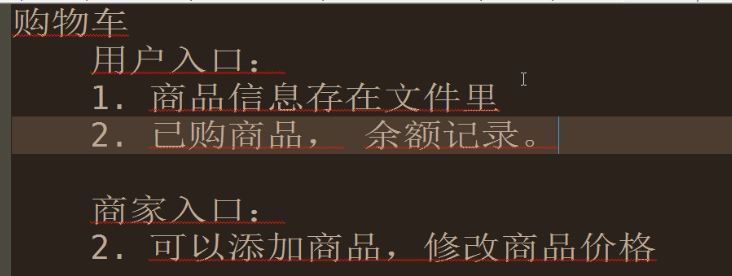
2.个人思路
商家入口
商品列表存到文件中,如何存?以什么形式存? 如何读取出来? 修改商品价格 覆盖原来的文件
用户接口
已购商品列表放入文件 shopping_cart,
薪水放入文件 salary,
if 薪水文件有数据
打印文件中的商品列表
else 输入新的薪水
if salary.isdigit():
执行下一步
选择的商品追加到shopping_cart
最后的salary 放到 文件中
3. 个人完整代码
商家入口
商品信息存入还是二维列表,
import json
while True:
with open("goods.txt","r") as g:
data = json.load(g)
for index,item in enumerate(data):
print(index,item)
choice = input(">> which goods price to change :")
if choice.isdigit():
if -1 < int(choice) < len(data):
print(data[int(choice)])
change_price = input("change it to >")
data[int(choice)][1] = int(change_price)
print('----change_after---
',data[int(choice)],'
')
with open("goods.txt","w") as g:
g.write(json.dumps(data))
elif choice == 'q':exit()
else:print("error you enter")
goods.txt文件信息! 二维列表存入,读写都是二维列表格式的

运行结果
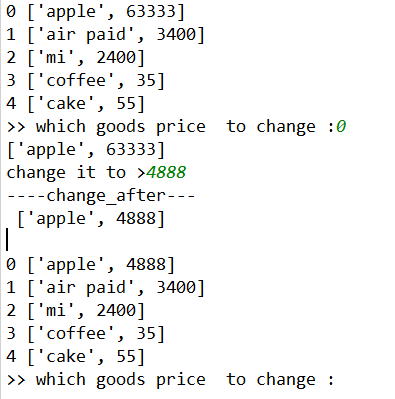
用户入口
# coding=utf-8
import json
shopping_cart = []
with open("salary") as f ,open("shopping_cart") as s_c:
# f = open("salary",'r')
user_salary = f.readline()
shopping_cart_buy = s_c.readlines()
# print(user_salary)
# print(shopping_cart_buy)
if user_salary:
print("�33[1m你还有¥%s人民币�33[0m"%user_salary)
if shopping_cart_buy:
print("---you had buy --
",shopping_cart_buy)
else:
user_salary = input("your salary is :").strip()
if user_salary.isdigit():
salary = int(user_salary)
while True:
print('-----the list ----')
with open('goods.txt','r') as g:
data = json.load(g)
for index,item in enumerate(data):
print(index,item)
choice1 = input(">>>enter your choice :" )
if choice1.isdigit():
choice = int(choice1)
if choice < len(data) and choice >= 0:
print('>>>your choice good is ',data[choice])
price = data[choice][1]
if price <= salary:
salary -= price
shopping_cart.append(data[choice])
else:
print("�33[1m余额不足,your salary is %s�33[0m"%salary)
else: print("�33[1menter error!!!�33[0m")
elif choice1 == 'q':
break
else: print("�33[1menter error!!!�33[0m")
print('-----the shopping_cart ----')
with open('shopping_cart','a+') as s_c:
for i in shopping_cart:
print(i)
s_c.write(json.dumps(i))
print('---------------------------
your salary:',salary)
with open('salary','w') as s:
s.write(json.dumps(salary))
else: print("�33[1menter error!!!�33[0m")
薪水文件

购物车文件

商品文件

运行结果
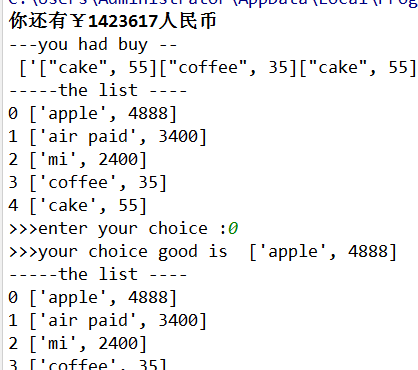
4.个人心得
4.1 文件指针问题
文件读取f.readlines(),全部读完的时候,文件指针会到文件末尾,此时如果继续读文件的话,读的数据为0
for line in goods.readlines(): #按行读取,把文件写到list列表中
print(line)
list.append(line.strip().split(','))
4.2文件数据读出
如何将数据读入list,或者字典中,然后对其进行操作

list = []
with open('goods1.txt','r+',encoding="utf-8") as goods:
for line in goods.readlines(): #按行读取,把文件写到list列表中
list.append(line.strip().split(','))
for index,item in enumerate(list):
print(index,item)
choice = input(">> which goods price to change :")
最后如何把list 按照原来文件的格式保存覆盖到文件中去??
比如,list 最后是一个二维列表
[["apple", 4888],["cake", 55]]
4.3 json pickle
序列化和反序列化
• json,用于字符串 和 python数据类型间进行转换
• pickle,用于python特有的类型 和 python的数据类型间进行转换
可以保证文件数据读入写入都是数据的本身格式,二维list,dict,str
数据如何存入文件?不影响其本身的类型,str,list,dict
反序列化 json.load(f)

将文件数据读出来
import json
while True:
with open("goods.txt","r") as g:
data = json.load(g) #文件数据导入,数据的类型不变
for index,item in enumerate(data):
print(index,item)
运行结果
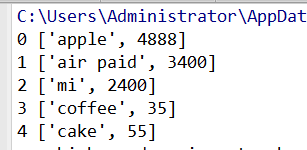
序列化
最后data 二维列表的数据存入文件中
with open("goods.txt","w") as g:
g.write(json.dumps(data))
将购物车信息,薪水信息,追加到文件中
with open('shopping_cart','a+') as s_c:
for i in shopping_cart:
s_c.write(json.dumps(i))
with open('salary','w') as s:
s.write(json.dumps(salary))
4.4 错误演示
程序1
文件 二维列表

import json
with open("goods.txt","r") as g:
data = json.load(g)
for index,item in enumerate(data):
print(index,item)
程序2
文件 只是单独的列表放进去,不是二维列表

import json
with open("shopping_cart",'r') as s_c:
data = json.load(s_c)
for index,item in enumerate(data):
print(index,item)
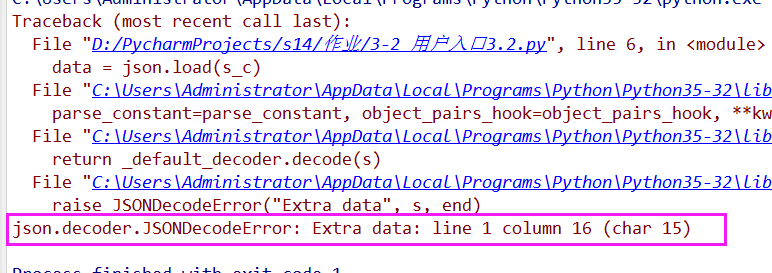
4.5 数据格式 文件
文件读入和读取,数据的格式是否变化,是否影响文件的改变,还是存在很大的不解!